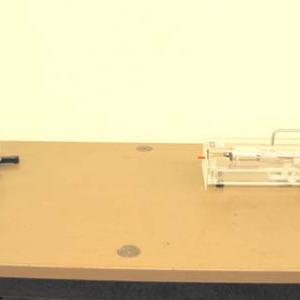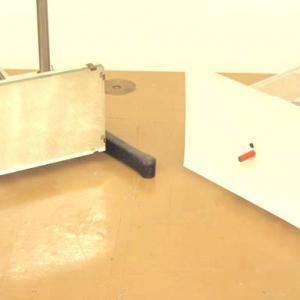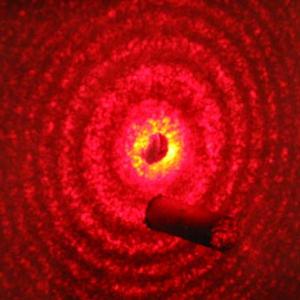College of Liberal Arts & Sciences
6D30.58 - Interference - Dusty Mirror
See also 6F40.80 in Optics.
Place the white screen with the hole in it onto the laser using the attached magnet. Sprinkle a light coat of chalk dust or Lycopodium powder onto the mirror and aim the laser at it. Adjust the mirror so that the reflection from the mirror goes directly back to the laser. You should be able to observe the scattered interference pattern on the white screen.
- Arnab Pal, Pradipta Panchadhyayee, Kriti R. Sahu, Debapriyo Syam, "A Novel Method for Measurement of the Refractive indices of Transparent Solid Media Using Laser Interferometry", TPT, Vol. 60, #1, Jan. 2022, p. 51.
- Charles A. Sawicki, "Easy and Inexpensive Demonstration of Light Interference", TPT, Vol. 39, #1, Jan. 2001, p. 16.
- Cyril Isenberg, "Laser Diffraction Experiments with Pseudoliquids and Pseudosolids", TPT, Vol. 38, #7, Oct. 2000, p. 411.
- Javier González, Anayeli Bravo, and Karol Juárez, "Interference of Laser Light Scattered from a 'Dusty' Plane Mirror", AJP, Vol. 67, #9, Sept. 1999, p. 839.
- F. A. Fischbach, J. S. Bond, "Fraunhofer Diffraction Patterns of Microparticles", AJP, Vol. 52, #6, June 1984, p. 519.
- A. K. Aggarwal and P. C. Gupta, "Scatter Light Interference Using Laser Speckles", AJP, Vol. 46, #11, Nov. 1978, p. 1193.
- Guenter Schwarz, "Historical Note on 'White-Light Interference Fringes'", AJP, Vol. 35, #11, Nov. 1967, p. ix.
- Robert H. Webb, "White-Light Interference Fringes", AJP, Vol. 35, #3, Mar. 1967, p. xxii.
- T. Kallard, "Interference in Scattered Light", Exploring Laser Light, p. 183.
- Jearl Walker, "6.110. Colored Rings from a Misty or Dusty Mirror", The Flying Circus of Physics Ed. 2, p. 287.
- Yaakov Kraftmakher, "4.1. Interference of Light", Experiments and Demonstrations in Physics, ISBN 981-256-602-3, p. 221.
Disclaimer: These demonstrations are provided only for illustrative use by persons affiliated with The University of Iowa and only under the direction of a trained instructor or physicist. The University of Iowa is not responsible for demonstrations performed by those using their own equipment or who choose to use this reference material for their own purpose. The demonstrations included here are within the public domain and can be found in materials contained in libraries, bookstores, and through electronic sources. Performing all or any portion of any of these demonstrations, with or without revisions not depicted here entails inherent risks. These risks include, without limitation, bodily injury (and possibly death), including risks to health that may be temporary or permanent and that may exacerbate a pre-existing medical condition; and property loss or damage. Anyone performing any part of these demonstrations, even with revisions, knowingly and voluntarily assumes all risks associated with them.


